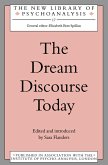30,95 €
30,95 €
inkl. MwSt.
Sofort per Download lieferbar

15 °P sammeln
30,95 €
Als Download kaufen

30,95 €
inkl. MwSt.
Sofort per Download lieferbar

15 °P sammeln
Jetzt verschenken
Alle Infos zum eBook verschenken
30,95 €
inkl. MwSt.
Sofort per Download lieferbar
Alle Infos zum eBook verschenken

15 °P sammeln
- Format: PDF
- Merkliste
- Auf die Merkliste
- Bewerten Bewerten
- Teilen
- Produkt teilen
- Produkterinnerung
- Produkterinnerung

Bitte loggen Sie sich zunächst in Ihr Kundenkonto ein oder registrieren Sie sich bei
bücher.de, um das eBook-Abo tolino select nutzen zu können.
Hier können Sie sich einloggen
Hier können Sie sich einloggen
Sie sind bereits eingeloggt. Klicken Sie auf 2. tolino select Abo, um fortzufahren.

Bitte loggen Sie sich zunächst in Ihr Kundenkonto ein oder registrieren Sie sich bei bücher.de, um das eBook-Abo tolino select nutzen zu können.
This fascinating and highly original book presents a longitudinal systematic study of the earliest form of human dreaming in a child, from ages four through ten.
- Geräte: PC
- mit Kopierschutz
- eBook Hilfe
Andere Kunden interessierten sich auch für
![The Dreams of a Child (eBook, ePUB) The Dreams of a Child (eBook, ePUB)]() Claudio ColaceThe Dreams of a Child (eBook, ePUB)30,95 €
Claudio ColaceThe Dreams of a Child (eBook, ePUB)30,95 €![Images of the Dead in Grief Dreams (eBook, PDF) Images of the Dead in Grief Dreams (eBook, PDF)]() Susan OlsonImages of the Dead in Grief Dreams (eBook, PDF)35,95 €
Susan OlsonImages of the Dead in Grief Dreams (eBook, PDF)35,95 €![Working With Dreams (eBook, PDF) Working With Dreams (eBook, PDF)]() Wolfgang GiegerichWorking With Dreams (eBook, PDF)33,95 €
Wolfgang GiegerichWorking With Dreams (eBook, PDF)33,95 €![A Jungian Understanding of Symbolic Function and Forms (eBook, PDF) A Jungian Understanding of Symbolic Function and Forms (eBook, PDF)]() Dominique BoukhabzaA Jungian Understanding of Symbolic Function and Forms (eBook, PDF)32,95 €
Dominique BoukhabzaA Jungian Understanding of Symbolic Function and Forms (eBook, PDF)32,95 €![The Dream Discourse Today (eBook, PDF) The Dream Discourse Today (eBook, PDF)]() Sara FlandersThe Dream Discourse Today (eBook, PDF)42,95 €
Sara FlandersThe Dream Discourse Today (eBook, PDF)42,95 €![A Guide to the World of Dreams (eBook, PDF) A Guide to the World of Dreams (eBook, PDF)]() Ole VedfeltA Guide to the World of Dreams (eBook, PDF)35,95 €
Ole VedfeltA Guide to the World of Dreams (eBook, PDF)35,95 €![A Dream in the World (eBook, PDF) A Dream in the World (eBook, PDF)]() Robin van Lõben SelsA Dream in the World (eBook, PDF)41,95 €
Robin van Lõben SelsA Dream in the World (eBook, PDF)41,95 €-
-
-
This fascinating and highly original book presents a longitudinal systematic study of the earliest form of human dreaming in a child, from ages four through ten.
Dieser Download kann aus rechtlichen Gründen nur mit Rechnungsadresse in A, B, BG, CY, CZ, D, DK, EW, E, FIN, F, GR, HR, H, IRL, I, LT, L, LR, M, NL, PL, P, R, S, SLO, SK ausgeliefert werden.
Produktdetails
- Produktdetails
- Verlag: Taylor & Francis eBooks
- Seitenzahl: 250
- Erscheinungstermin: 9. Juni 2022
- Englisch
- ISBN-13: 9781000598315
- Artikelnr.: 63775704
- Verlag: Taylor & Francis eBooks
- Seitenzahl: 250
- Erscheinungstermin: 9. Juni 2022
- Englisch
- ISBN-13: 9781000598315
- Artikelnr.: 63775704
- Herstellerkennzeichnung Die Herstellerinformationen sind derzeit nicht verfügbar.
Claudio Colace, M.D., Ph.D., is a psychologist and psychotherapist at the Operational Unit of Psychology of the ASL Viterbo (National Health Service Office, Italy), where he works at the Outpatient Psychology Department and at the Center for Drug Addictions of Civita Castellana (Viterbo). He obtained an M.D. in Psychology at the University of Rome "La Sapienza", a post-graduate Master in Neurophysiology of Consciousness State, Psychopathology and Psychotherapy at the University of Rome "La Sapienza" and a Ph.D. in Psychology at the Department of Psychology of the University of Bologna, Italy. He is the author of scientific contributions published in The American Journal on Addictions, Neuropsychoanalysis, Alcohol and Drug Review, Sleep and Hypnosis, Sleep and Sleep Research. He is the author of Children's Dreams: From Freud's Observations to Modern Dream Research (London, 2010, Karnac Books); Drug Dreams: Clinical and Research Implications of Dreams about Drugs in Drug-addicted Patients (London, 2014, Karnac Books); and of some Encyclopedia of Personality and Individual Differences entries: "Dream", "Latent Dream Content" and "Manifest Dream Contents" (eds. V. Zeigler-Hill and T. Shackelford, Springer International Publisher, 2018).
Introduction Part 1: Methodological aspects of the study 1. The credibility
of children's dream reports 2. The methodology of this study Part 2: The
debut of dreaming activity: infantile dreams (ages four to five) 3. The
predominance of clear wish-fulfilment dreams 4. Nature of the wishes
appearing in dream reports 5. Daytime sources and triggering conditions of
clear wish-fulfilment dreams 6. How do dreams act? The modus operandi of
clear wish-fulfilment dreams 7. Less common forms of dreaming in infancy
Part 3: The decline of infantile forms of dreaming (ages six to seven) 8.
Changes in dream repertoire and developments in wish-fulfilment dreaming 9.
Development of dream bizarreness and dream-work operations 10. Bad dreams
11. Ego and super-ego development and changes in dreaming Part 4: Dreaming
in middle childhood (ages eight to ten) 12. Changes in dream repertoire and
developments in wish-fulfilment dreams at ages 8-10 13. Dream distortion
and new dream-works operations 14. Changes in bad dreams Part 5: The
meaning and function of infantile dreams 15. The function of dreams: the
affective-reestablishment (AR) hypothesis 16. Infantile forms of dreaming
in adults 17. A new ontogenetic psychological-psychoanalytic model of dream
Conclusions
of children's dream reports 2. The methodology of this study Part 2: The
debut of dreaming activity: infantile dreams (ages four to five) 3. The
predominance of clear wish-fulfilment dreams 4. Nature of the wishes
appearing in dream reports 5. Daytime sources and triggering conditions of
clear wish-fulfilment dreams 6. How do dreams act? The modus operandi of
clear wish-fulfilment dreams 7. Less common forms of dreaming in infancy
Part 3: The decline of infantile forms of dreaming (ages six to seven) 8.
Changes in dream repertoire and developments in wish-fulfilment dreaming 9.
Development of dream bizarreness and dream-work operations 10. Bad dreams
11. Ego and super-ego development and changes in dreaming Part 4: Dreaming
in middle childhood (ages eight to ten) 12. Changes in dream repertoire and
developments in wish-fulfilment dreams at ages 8-10 13. Dream distortion
and new dream-works operations 14. Changes in bad dreams Part 5: The
meaning and function of infantile dreams 15. The function of dreams: the
affective-reestablishment (AR) hypothesis 16. Infantile forms of dreaming
in adults 17. A new ontogenetic psychological-psychoanalytic model of dream
Conclusions
Introduction Part 1: Methodological aspects of the study 1. The credibility of children's dream reports 2. The methodology of this study Part 2: The debut of dreaming activity: infantile dreams (ages four to five) 3. The predominance of clear wish-fulfilment dreams 4. Nature of the wishes appearing in dream reports 5. Daytime sources and triggering conditions of clear wish-fulfilment dreams 6. How do dreams act? The modus operandi of clear wish-fulfilment dreams 7. Less common forms of dreaming in infancy Part 3: The decline of infantile forms of dreaming (ages six to seven) 8. Changes in dream repertoire and developments in wish-fulfilment dreaming 9. Development of dream bizarreness and dream-work operations 10. Bad dreams 11. Ego and super-ego development and changes in dreaming Part 4: Dreaming in middle childhood (ages eight to ten) 12. Changes in dream repertoire and developments in wish-fulfilment dreams at ages 8-10 13. Dream distortion and new dream-works operations 14. Changes in bad dreams Part 5: The meaning and function of infantile dreams 15. The function of dreams: the affective-reestablishment (AR) hypothesis 16. Infantile forms of dreaming in adults 17. A new ontogenetic psychological-psychoanalytic model of dream Conclusions
Introduction Part 1: Methodological aspects of the study 1. The credibility
of children's dream reports 2. The methodology of this study Part 2: The
debut of dreaming activity: infantile dreams (ages four to five) 3. The
predominance of clear wish-fulfilment dreams 4. Nature of the wishes
appearing in dream reports 5. Daytime sources and triggering conditions of
clear wish-fulfilment dreams 6. How do dreams act? The modus operandi of
clear wish-fulfilment dreams 7. Less common forms of dreaming in infancy
Part 3: The decline of infantile forms of dreaming (ages six to seven) 8.
Changes in dream repertoire and developments in wish-fulfilment dreaming 9.
Development of dream bizarreness and dream-work operations 10. Bad dreams
11. Ego and super-ego development and changes in dreaming Part 4: Dreaming
in middle childhood (ages eight to ten) 12. Changes in dream repertoire and
developments in wish-fulfilment dreams at ages 8-10 13. Dream distortion
and new dream-works operations 14. Changes in bad dreams Part 5: The
meaning and function of infantile dreams 15. The function of dreams: the
affective-reestablishment (AR) hypothesis 16. Infantile forms of dreaming
in adults 17. A new ontogenetic psychological-psychoanalytic model of dream
Conclusions
of children's dream reports 2. The methodology of this study Part 2: The
debut of dreaming activity: infantile dreams (ages four to five) 3. The
predominance of clear wish-fulfilment dreams 4. Nature of the wishes
appearing in dream reports 5. Daytime sources and triggering conditions of
clear wish-fulfilment dreams 6. How do dreams act? The modus operandi of
clear wish-fulfilment dreams 7. Less common forms of dreaming in infancy
Part 3: The decline of infantile forms of dreaming (ages six to seven) 8.
Changes in dream repertoire and developments in wish-fulfilment dreaming 9.
Development of dream bizarreness and dream-work operations 10. Bad dreams
11. Ego and super-ego development and changes in dreaming Part 4: Dreaming
in middle childhood (ages eight to ten) 12. Changes in dream repertoire and
developments in wish-fulfilment dreams at ages 8-10 13. Dream distortion
and new dream-works operations 14. Changes in bad dreams Part 5: The
meaning and function of infantile dreams 15. The function of dreams: the
affective-reestablishment (AR) hypothesis 16. Infantile forms of dreaming
in adults 17. A new ontogenetic psychological-psychoanalytic model of dream
Conclusions
Introduction Part 1: Methodological aspects of the study 1. The credibility of children's dream reports 2. The methodology of this study Part 2: The debut of dreaming activity: infantile dreams (ages four to five) 3. The predominance of clear wish-fulfilment dreams 4. Nature of the wishes appearing in dream reports 5. Daytime sources and triggering conditions of clear wish-fulfilment dreams 6. How do dreams act? The modus operandi of clear wish-fulfilment dreams 7. Less common forms of dreaming in infancy Part 3: The decline of infantile forms of dreaming (ages six to seven) 8. Changes in dream repertoire and developments in wish-fulfilment dreaming 9. Development of dream bizarreness and dream-work operations 10. Bad dreams 11. Ego and super-ego development and changes in dreaming Part 4: Dreaming in middle childhood (ages eight to ten) 12. Changes in dream repertoire and developments in wish-fulfilment dreams at ages 8-10 13. Dream distortion and new dream-works operations 14. Changes in bad dreams Part 5: The meaning and function of infantile dreams 15. The function of dreams: the affective-reestablishment (AR) hypothesis 16. Infantile forms of dreaming in adults 17. A new ontogenetic psychological-psychoanalytic model of dream Conclusions
In his new book, The Dreams of a Child, Claudio Colace details a seven-year longitudinal study of his son's dreams. This book takes readers on a journey into the developmental course of dreaming and vividly shows how dreams reach a crescendo of dynamic complexity in childhood. The Dreams of a Child is a must-read for anyone interested in the contemporary Freudian view of children's dreams.
Calvin Kai-Ching Yu, Professor at Hong Kong Shue Yan University
Calvin Kai-Ching Yu, Professor at Hong Kong Shue Yan University







